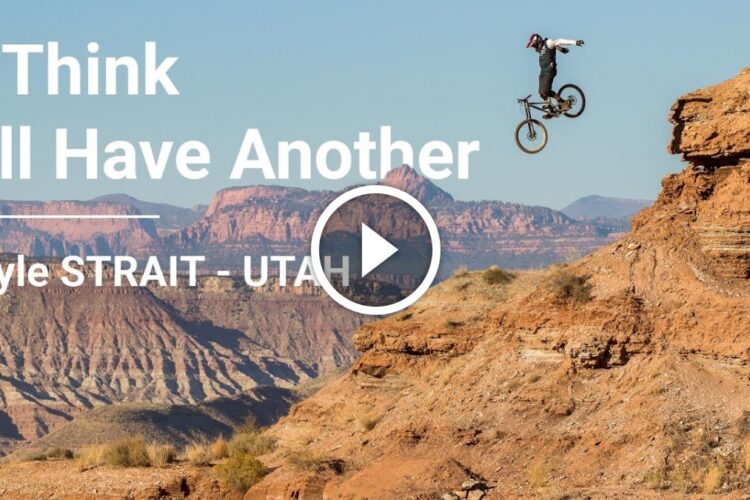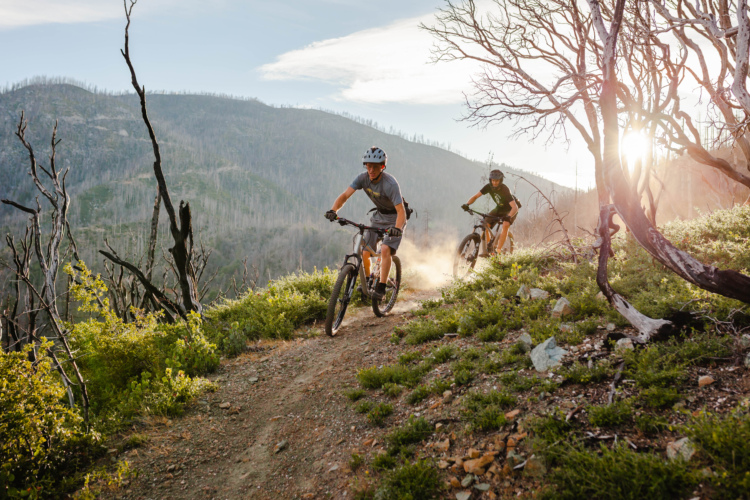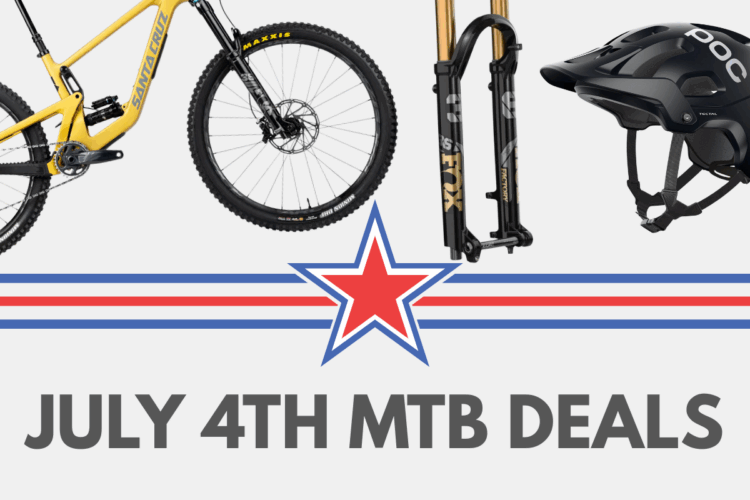Here in the Rocky Mountains we don’t really have mud to deal with and serious roots exist only on some specific, high altitude trails. Most of our trails are rocky, sandy, hardpack, or all of the above. Almost any brand name mountain bike tire suited to your favorite style of riding will handle the trail surfaces just fine but there are a few standout models you should know about.
WTB Velociraptor (26″ only)
WTB has been making this tire for 13 years now with almost no design changes. With differing front and rear treads, each end of the bike gets the specific traction it needs, and the treads and sidewalls are extremely durable. There are two 2.1″ models: a 795 gram comp model with a steel bead and a 700 gram race version with an aramid bead and lightweight casing. Because WTB has manufactured them for so long, economies of scale have reduced the price to $20 or less per tire, and you can find them almost anywhere. As an all-around tire, there is nothing better in this price range. They have incredible traction, strong sidewalls that hold up well to sharp rocks, and they can be run at a fairly low pressure. I haven’t tried it, but I have heard that they work well for tubeless with a Stan’s type conversion.
On the downside, even the race version is portly by today’s weight standards. WTB markets them as an XC tire but they weigh more than some all mountain tires. All that traction also comes with the price of high rolling resistance.
Bottom line: These are a tried and true tire that cannot be beat for the price. They have their shortcomings, but they will get you there and back without breaking the bank.
Panaracer Fire XC Pro (26″ only, standard and UST)
The distinctive red sidewalls of the Fire XC are immediately recognizable on the trail. As another tire that has been around a while, they have developed a cult following among XC and trail riders. Unlike the Velociraptors, these tires are offered in a single model intended for either the front or the rear. The only complaints I have heard about them is that occasionally one or more knobs will separate from the casing, and the rolling resistance is fairly high. On the bright side, they weigh 575 grams and their high speed cornering prowess is legendary. Panaracer has made subtle changes to the model over the years to improve durability and reduce weight and they’ve recently introduced a UST version.
Bottom line: These run double the price of the Velociraptors and don’t offer the distinct front and rear models, but their low weight andimpressivecornering may just have you seeing red – sidewalls, that is.
Maxxis High Roller (26″ only, standard and UST)
Maxxis has done an excellent job getting pro riders onto their products. From XC to All Mountain and Downhill they have a dizzying selection of models to choose from. The High Roller is billed as their ‘do-it-all’ model, and they offer it in three sizes with two bead designs and three rubber compounds. As a 490 gram 1.90″ XC tire it’s well suited for ultra endurance racing. Stepping up to the 2.50″ All Mountain version at a whopping 1,250 grams helps ensure a surefooted landing from even the craziest drops – if you can pedal all that rubber up the hill! All models of the High Roller share the same tread design that rolls fast, hooks up securely for accelerating and braking, and has very predictable cornering.
Bottom line: The tread design of the High Roller is a well established performer and the variety of sizes, beads, and rubber compounds means you can find one suited to any riding discipline from 24 hour solo racing to lift-assisted downhill.
Geax AKA (26″ and 29″ standard and UST)
The Geax AKA is a race-bred XC tire with a focus on fast rolling and solid cornering. As a fairly recent design, the 2.2″ version tips the scales at 590 grams per tire and is a testament to modern advances in tire tech. The knobs are stiff and the pattern is closely spaced which lowers the rolling resistance while also providing a solid hookup when you push the limits.
Bottom line: The tread on the AKA is particularly well suited to terrain in the southwest and they are an excellent choice for all day riding on fast, twisty singletrack. However, this is not an All Mountain tire.
Kenda Nevegal (26″, 29″, and 650b; Standard, UST and 2-ply DH)
A quick survey of my riding club revealed the Nevegal to be an overwhelming favorite for our corner of the US. Originally designed with input from racing legend John Tomac, this tire, like the Maxxis, has evolved to include a myriad of size, bead, and rubber compound offerings. One of my riding buddies summed it up by describing the Nevegal as an almost perfect compromise that perhaps doesn’t excel at any one thing, but as a package provides a tire that you don’t have to think about while riding: it just performs.
Bottom line: Again like the High Roller, the Nevegal offers a proven tread design shared across a wide variety of models so you can find a pair suited for your exact style of riding. All that variety means you could even shod multiple bikes in your shed with the same tread pattern – how’s that for a consistent ride?
Whether you live in the southwest or the Rocky Mountains or you’re traveling here for that epic riding vacation, any of these tires should work out great for you – just make sure you match the tire to your own riding style!























14 Comments
May 6, 2011
@tcarbone, Where in SoCal do you ride at? I'm from LA and used to ride up in the Mt. Wilson area a lot before the fires ofcourse and in Topanga Cyn/Simi Valley/Cheesboro.
I rock that same combo of the slant6 front and small block8 rear cause I commute on my mtb but it works well on a few trails out here. I am not 100% confident to ride thru soft sand at full speed with the slant6 but never the less it works well..
Feb 9, 2012
at the tire and the side nobs it seems that it would. Lots of other tires are just slick sidewall on
that part of the tire. Can you explain a little more? I ride hardpack covered with
granite pebbles and sand which can be slick when cornering. Do you recommend a little
lower tire pressure in these conditions? I'm thinking of going with the navegals as they have
gotten good reviews for an all around tire from what I have seen. Appreciate any comments.
My next bike will be a 29er and I see that Panaracer doesn't have those but for now on
my 26er it would be good to know.
May 5, 2011
One thing I never found was a good sand tire. I guess it's because most trails in the southwest just have short bursts of sand so it would be silly to design a tire specifically for really loose sand. That is, unless you're riding on sand dunes at the beach or something. :)
Do you have any specific recommendations on tire pressures for the terrain out there? I remember having to adjust to higher pressures than I was used to riding on the east coast - seems like I got a pinch flat on almost every ride for the first few months I lived in Colorado.
I know a lot of people are running tubeless tires these days but do you recommend using a sealant with tubed tires to guard against sharp rocks / cacti?
May 5, 2011
May 5, 2011
May 5, 2011
I have never had a puncture from a cactus, but I have encountered numerous goatheads. Stan's sealant in a tubeless setup handles these just fine, or you can put a product called True Goo into your tubes for the same net effect. (pull out the goathead(s) and spin the tire to seal) True Goo is a great sealant and is made right here in Colorado.
May 5, 2011
May 5, 2011
May 6, 2011
The Panaracer XC Pros of the past had too outward facing knobs on the outer layer of bumps preventing proper cornering for a front tire, no problem on the back. Hopefully it's improved.
May 5, 2011
May 5, 2011
May 5, 2011
May 5, 2011
May 11, 2011
Yesterday I tried this combo - slant six Frt sb 8 rr at the sqaw loop leep called something gorge now in auberry (40 mi east of fresno) with crushed granite some sand, light mud, some soft dirt, slick rock etc. slant six on front was good the sb 8 was scary in anything other than slick rock... was out of town on business and could not bring my spare set of wheels tires and did not really know the terrain. had fun tho!
you are right in deep sand is not good but niether are the nevegals imo.